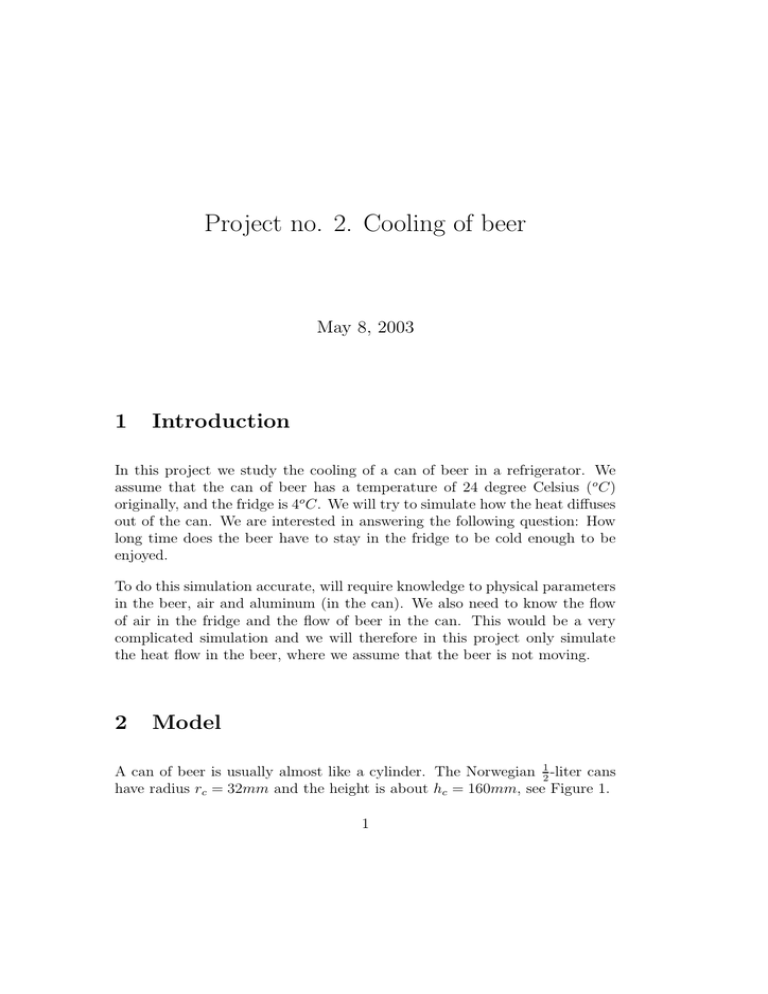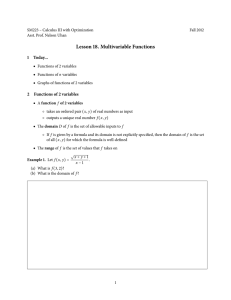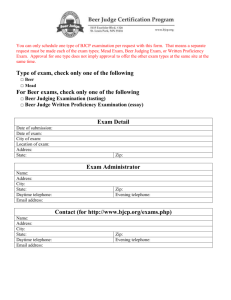Project no. 2. Cooling of beer 1 Introduction May 8, 2003
advertisement

Project no. 2. Cooling of beer May 8, 2003 1 Introduction In this project we study the cooling of a can of beer in a refrigerator. We assume that the can of beer has a temperature of 24 degree Celsius (o C) originally, and the fridge is 4o C. We will try to simulate how the heat diffuses out of the can. We are interested in answering the following question: How long time does the beer have to stay in the fridge to be cold enough to be enjoyed. To do this simulation accurate, will require knowledge to physical parameters in the beer, air and aluminum (in the can). We also need to know the flow of air in the fridge and the flow of beer in the can. This would be a very complicated simulation and we will therefore in this project only simulate the heat flow in the beer, where we assume that the beer is not moving. 2 Model A can of beer is usually almost like a cylinder. The Norwegian 21 -liter cans have radius rc = 32mm and the height is about hc = 160mm, see Figure 1. 1 rc =32mm h c=160mm Figure 1: The can of beer is approximately a cylinder with height hc = 160mm and radius rc = 32mm The three dimensional heat conduction equation reads %cv ∂T = ∇ · (k∇T ) + f (x, y, z, t), ∂t (1) where T (x, y, z, t) is the temperature, % is mass density, cv is the specific heat capacity, k is heat conductivity and f (x, y, z, t) is the generated heat per unit time and per unit volume, see Equation (7.22) in [1]. Since most of the beer is water, we assume that the physical properties of beer are equal to water. The physical properties of water are as follows: kg • % = 1000 m 3 • cv = 4200 kgJK • k = 0.58 mWK (The mass density of water) (The specific heat capacity) (The approximate heat conductivity) All these numbers will vary with pressure and temperature, but these are the approximate numbers at room temperature and with earth pressure. 2 3 Simplifications We assume that the physical properties, %, cv and k, are constant and that there is no generated heat in the beer, f (x, y, z, t) = 0. Equation (1) can therefore be simplified to ∂T k = ∇ · (∇T ) , ∂t %cv where ∇ · (∇T ) = 3.1 (2) ∂2T ∂2T ∂2T + + . ∂x2 ∂y 2 ∂z 2 Invariance in z-direction We assume there is no variation in z. This means that ∂T ∂z = 0 or T = T (x, y, t). Equation (2) can then be simplified to k ∂T (x, y, t) = ∇ · (∇T (x, y, t)) , ∂t %cv where ∇ · (∇T (x, y, t)) = (3) ∂ 2 T (x, y, t) ∂ 2 T (x, y, t) + . ∂x2 ∂y 2 In practice the assumption ∂T = 0, will not be true. However, if the bot∂z tom and the top of the can of beer are insulated, it will be a reasonable assumption. In that case, no heat can flow out of the bottom and the top and physically it seems reasonable that all changes in temperature are in (x, y)-directions. Another situation where the above assumption is reasonable is if the height is much larger than the radius. Then the temperature variations in z-direction will be small if you are far away from the bottom and the top. 3 r c=32mm Figure 2: We only do simulations in a disc with radius rc = 32mm 3.2 Polar coordinates We now have a two dimensional problem with circular geometry. The solution is therefore assumed to be radially symmetric, i.e. T = T (r, t), where the coordinate system is placed with origo at the center of the circle. Physically this is reasonable since: initially the temperature is constant, which is a radially symmetric function, and the boundary (r = rc ) is symmetric and therefore heat flow will be symmetric. It can be shown that ∇ · (∇T (r, t)) = 1 ∂ ∂T (r, t) (r ), r ∂r ∂r (4) when T is a radially symmetric function T = T (r, t). Thus (3) can be written k 1 ∂ ∂T (r, t) ∂T (r, t) = (r ). ∂t %cv r ∂r ∂r 4 (5) 3.3 Initial conditions We assume that the temperature is 24 o C initially, i.e. (= 24o C). T (r, 0) = T0 3.4 (6) Boundary conditions If the fridge is large compared to the can of beer, we can assume that the air in the fridge is constant at 4 o C, Tf = 4. Newton’s law of cooling says that the heat flow out of the boundary is proportional to the difference between the temperature in the beer and the temperature in the fridge (the aluminium in the can is very thin), i.e. −k ∂T (rc , t) = hT (T (rc , t) − Tf ). ∂r (7) Here the heat transfer coefficient will usually be approximately hT = 5 W , m2 K (8) when the air is not moving. However, if the air in the fridge starts to move the coefficient will increase. If the air moves very much, we get the boundary condition: T (rc , t) = Tf . (9) a) Show that (9) follows from (7) when hT → ∞. (Hint: assume that (rc ,t) | ∂T ∂r | < ∞) It can be shown that the boundary condition for r = 0 is ∂T (0, t) = 0. ∂r 5 (10) We assume that (9) is valid and write the full system k 1 ∂ ∂T (r, t) ∂T (r, t) = (r ), ∂t %cv r ∂r ∂r ∂T (0, t) = 0 ∂r T (rc , t) = Tf T (r, 0) = T0 (r, t) ∈ (0, rc ) × (0, tend ) (11) (12) (13) (14) If Newton’s law of cooling is used for the boundary, then (13) is replaced with −k ∂T (rc , t) = hT (T (rc , t) − Tf ). ∂r (15) Above rc = 0.032 m, Tf = 4o C, T0 = 24o C and tend is the end time. 4 Scaling The problem is scaled in the following way r̄ = r , rc T̄ = T − Tf T0 − T f and t̄ = t , tc (16) where rc = 0.032 m, Tf = 4o C, T0 = 24o C and tc is the characteristic time (see question e)). b) Show that ∂T T0 − Tf ∂ T̄ = . ∂t tc ∂ t̄ (17) c) Show that 1 ∂ r ∂r ∂T r ∂r T0 − T f 1 ∂ = rc2 r̄ ∂ r̄ 6 ∂ T̄ r̄ . ∂ r̄ (18) d) Show that the Newton’s law of cooling on scaled form can be written − e) Choose tc = %cv rc2 k k ∂ T̄ (1, t̄) = T̄ (1, t̄). hT rc ∂ r̄ and show that (11)-(14) can be written ∂ T̄ ∂ T̄ 1 ∂ r̄ , (r̄, t̄) ∈ (0, 1) × (0, t̄end ) = ∂ t̄ r̄ ∂ r̄ ∂ r̄ ∂ T̄ (0, t̄) = 0 ∂ r̄ T̄ (1, t̄) = 0 T̄ (r̄, 0) = 1. 4.1 (19) (20) (21) (22) (23) Discretization In the following we define u = T̄ and x = r̄, and write the system on scaled form: ∂u 1 ∂ ∂u = x , (x, t̄) ∈ (0, 1) × (0, t̄end ) (24) ∂ t̄ x ∂x ∂x ∂u (0, t̄) = 0 (25) ∂x u(1, t̄) = 0 (26) u(x, 0) = 1, (27) when hT = ∞. When hT < ∞, (26) is replaced with − k ∂u (1, t̄) = u(1, t̄). hT rc ∂x (28) Note that these equations are on dimensionless form (only numbers) To discretize this problem we choose a number of spatial discretization points, n, and a number of temporal discretization points, m. We define the discretization parameters ∆x = 1 n−1 and ∆t = 7 1 . m The discretization points are (xi , t` ) = ((i − 1)∆x, `∆t), i = 1, . . . , n, ` = 0, . . . , m. The numerical solution u`i approximates the exact solution u(xi , t` ) in the discretization points, i.e. u`i ≈ u(xi , t` ), i = 1, . . . , n, ` = 0, . . . , m. (29) f ) Write a numerical scheme for solving Equation (24) in the grid points. (The scheme should be a finite difference scheme on explicit Euler form, as described in Chapter 7.3 in [1].) The boundary condition (25) shall in this project be discretized by u`1 − u`2 =0 ∆x (30) which gives u`1 = u`2 , for ` = 0, . . . , m. (31) g) Show how the boundary conditions (26) and (28) and the initial condition (27) can be incorporated into the finite difference scheme. h) Write an algorithm for solving (24)-(27) with the finite difference method. i) Write an algorithm for solving (24)-(25) and (27)-(28) with the finite difference method. 4.2 Implementation In the simulations we do not need to store all the values for u`i . We are just interested in the temperature in the last time step. j) Write the algorithms in h) and i), in such a way that only the storage of 2n numbers are needed for u. 8 k) Implement the algorithms from j) in one of the following languages: Matlab, Python, Java, C++, C or Fortran. l) Based on numerical experiments, discuss stability. Discuss briefly accuracy (we define the solution to be accurate enough when decreasing ∆x and ∆t gives small changes in the solution). For the next questions, use at least 40 spatial discretization points (n > 40), in order to get sufficient accurate solutions. Answer the following questions for both two codes. m) Make the code such that it stops the simulations when u`1 < 0.1. What is the smallest t̄ = ∆t` such that u`1 < 0.1. Pn ` n) Make the code such that it stops the simulations when k=1 2 uk xk < 0.1. Pn What is the smallest t̄ = ∆t` such that k=1 2 u`k xk < 0.1. Now we go back to the original problem. o) At what time (nonscaled time) is the temperature at the centre of the can of beer 6o C? p) At what time is the average temperature in the beer 6o C? q) In practice the value of the heat transfer coefficient, hT , is hard to determine. Answer o) and p) when hT = 10 mW2 K and hT = 18 mW2 K . References [1] A. Tveito, X. Cai, H. P. Langtangen and B. F. Nielsen, Introduction to Scientific Computing Written for INF 165. 9





